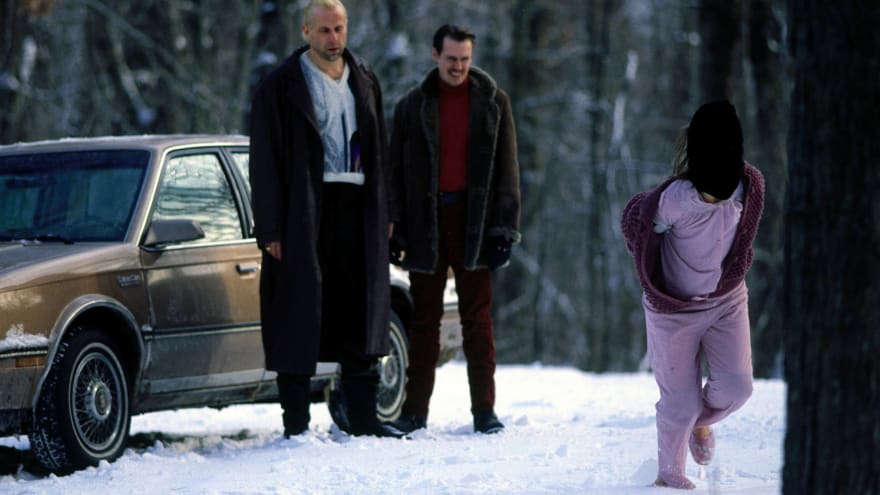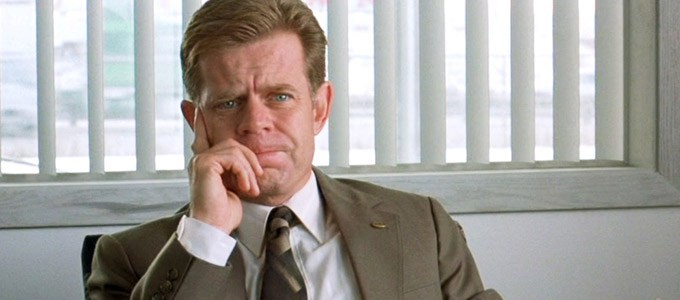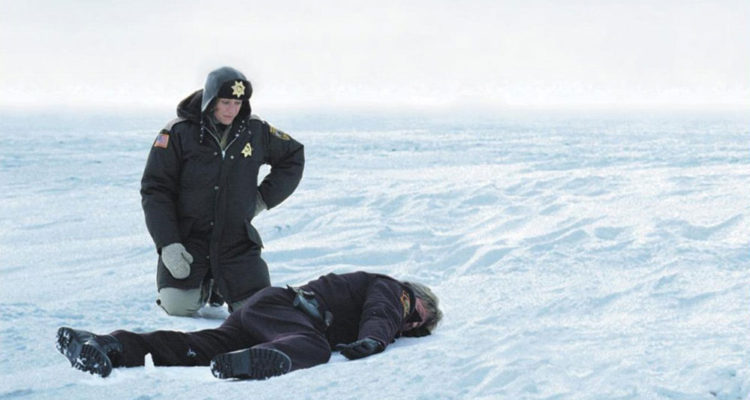By Mado Gianni,
There are so many reasons why I love Fargo, a film written by Ethan and Joel Coen and directed by Joel in 1996. It is not just that I am a fan of this creative duo, but Fargo is also an objectively brilliant film.
Allegedly based on true events, but on an entirely fictionalized ensemble of characters, Fargo opens with an image of a cold, white highway somewhere in Minnesota. Jerry Lundergaard meets up with two criminals to arrange the kidnapping of his wife. His plan is to get the ransom money from his father-in-law, get his wife home safe, and pay off his debt. If only things ever did go as planned.
It must be the framing of most shots that so successfully establishes the world of the film in Fargo. The outdoor frames of the vast and never-ending roads give us a very strong sense of space. Wide and flat, the frames allow for a kind of voyeuristic experience. There is no place to hide, which for Carl (Steve Buscemi) and Gaear (Peter Stormare), the two criminals, will have detrimental consequences in the story.
Frames of indoor spaces give us a good sense of space as well, such as the one taken by the upper corner of the hotel room where the two bandits are having sex with two hookers. We revisit the same frame just seconds later, but now all four of them are watching television in the dark. There is not much more information that the audience needs. Framing speaks volumes for the characters, their attitudes, and their behaviors.

I find that the most interesting films are the ones that are subtle when the dialogue is not particularly centered on advancing the narrative. The Coens prefer to speak to the audience with body language techniques or facial expressions, while their use of dialogue serves mostly the purpose of maintaining tone. My favorite line in Fargo and probably in the entirety of their films, in general is the repeated use of “Yeah” by several characters at several different moments.
The Coens explore conflict mainly through body language, without giving us a clear understanding of their characters’ motivations or relationships with one another. This makes for some of the most entertaining scenes in Fargo. A good example would be the relationship between Carl and Gaear. In the opening scene at the bar, I thought these two were long-time associates as Carl was the talkative one, while Gaear never uttered a word, letting Carl speak for him. But moving through the story, it is gradually revealed that not only are they not long-time associates, but they have probably not worked together before.
Instead of being handed a relationship label, we are given a first-class opportunity to observe how this will pan out. One very effective way to enhance this is the choice of camera angle for the reverse shots in the car. The shots create such intimacy that the viewer feels like they are at the receiving end of every line of dialogue or reaction between them. Similarly, all the car reverse shots with Marge and Lou have the same effect.
I admire and appreciate the fact that Marge, the main protagonist, is introduced to us at the right time and not at the beginning of the film. They could have easily cut to her after the opening scene to give us better genre orientation, but they did not – and that is bold of them. It also makes for a better delivery of the story.

The subtlety of their writing has one more crucial outcome and that is the twist from comedy to horror and vice versa. The action is unexpected, as the tone of the film resembles that of a horror film, where we are slowly confronted by hideous events. Yet, at the same time, the characters are so ordinary, that their reactions reach the point of comicality. A great example of this is the kidnapping scene where Jean Lundergaard (Kristin Rudrud) is knitting in front of the television, when she sees a man with a black garment over his head and a quite threatening tool, walking up to the window and peeping inside the house. The anticipation of what the man is going to do next combined with Jean’s total obliviousness is golden material. The performance of the actors is also incredible, and it does justice to every bit of this script.
The Coens employ parallel story structures, in order to convey information, which I find are cleverly thought out and beautifully weaved into the main narrative. One of these would be Marge’s reconnection with her former classmate, Mike Yanagita (Steve Park). Through this parallel arc, Marge is subtextually led into connecting the dots of the murder mystery. We already know what happened, because we have observed the action from its pre-conception to the actual kidnapping and to the subsequent murders. And yet, the film is as exciting, dare I say even more so than if we were just following Marge on her journey to catch the killers.
Another more obvious parallel arc is the one about Jerry’s business proposal to his father-in-law, which solidifies and reinforces the main narrative where Wade (Harve Presnell) does not trust Jerry to deliver the ransom money. This is beautiful storytelling.
The film comes full circle in the resolution where it is finally clear what the message of the film is: leading a simple life is probably the most rewarding of all life experiences. The importance of breakfast. And lunch. Remembering to shop for worms for your husband. Celebrating the fact that your artwork will be used for the three-cent stamp. It is the little things that make a difference in life and in the film.

The framing lets the actors underact, which is essential for the story arc and also helps in creating comfortable sets where everything feels ordinary. The characters, on the other hand, are comically written to accentuate the simplicity of daily dialogue, whilst making the banal aspects of life extremely funny. Everything is kind of underplayed and targeted towards simplicity that makes the resolution feel so much more impactful. The film ends with Marge and Norm, a simple suburban couple, watching television before falling asleep, in a comfortable bed, in a loving embrace. The contrast of that image to the horrific events that preceded it, has a once in a lifetime message attached to it.
Fargo is one of these films that are simply enjoyable to watch all the way through. Time after time. They are crafted in a way that every scene has something to offer, while at the same time the combination of its parts makes for an insanely captivating story.
References
- Is the Coen Brothers’ movie ‘Fargo’ a true story?, decider.com, Available here.




